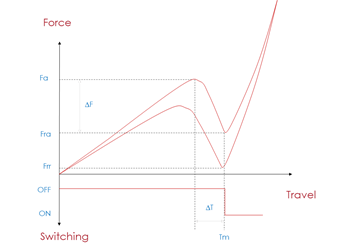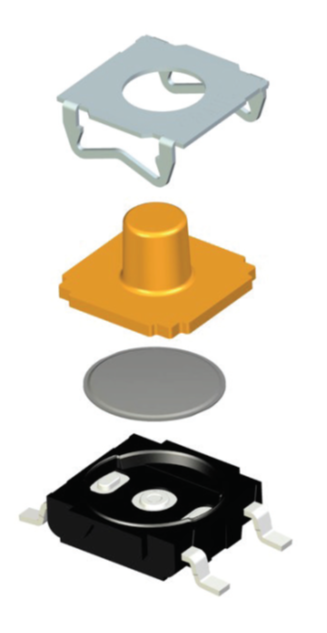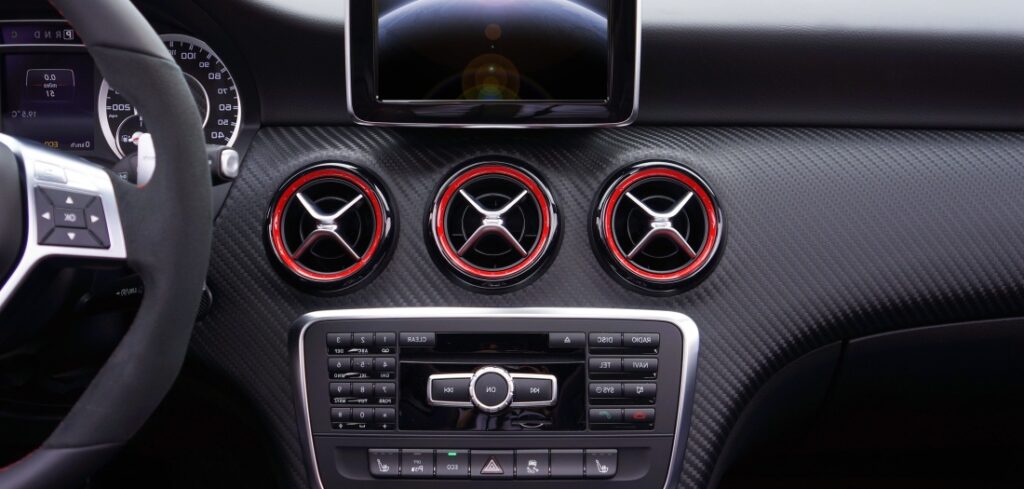Introduction
User interfaces have always been a vital aspect of the driving experience. The look, feel and method of interface interaction is one way that vehicle manufacturers separate themselves from competing auto makers. Known in the industry as haptics, electromechanical switches play a large role in defining the touch, feel and sound of interface actuation. Haptic features are customized for specific vehicles and manufacturers and are often accomplished through advanced switch configurations. With the evolution of automotive technology, the modern vehicle cabin features customized electromechanical switches that maximize functionality and optimize comfort, safety and more.
Haptics overview
As the gateway to a user interface, a switch solution must have a desirable appearance, feel and sound. To achieve this result, switch manufacturers work closely with automotive manufacturers to optimize aesthetics, ergonomics and performance.
Haptics is directly linked to the switch’s mechanical features and is a combination of:
- Actuation force (Fa)
- Actuation return force (Fra)
- Tactile effect (Fa-Fra = ΔF) often represented in % (ΔF/Fa = Δ%)
- Mechanical travel (Tm)
- Return force (Frr)

Switch manufacturers like C&K can adapt or change the components and parameters to create a unique haptic experience that defines an OEM product. From short-travel products with a strong click and loud noise, to a long-travel product with silent actuation, customization is the hallmark of today’s vehicles.
Automotive OEMs are focusing more and more on sound responses and consider the acoustic response as part of their branding. The audible response is highly dependent on the switch design, and vehicle manufacturers need to get the same sound response for all units, regardless of the switch configuration. The actuation sound, typically categorized as inaudible, soft, low, ‘metallic’ or loud, can be controlled by the internal design, the mechanical properties and the materials used.

To provide solutions that deliver repeatable audible responses, switch manufacturers have established platforms that allow designs to carry over to different applications. This unique offer provides high-reliability, consistent haptics via an automotive-proven series while also achieving drastically reduced development cost and time.
OEMs are approaching electromechanical component manufacturers for more than just the switch. By utilizing a switch manufacturer for designs beyond the switch itself, increased flexibility in design can be realized. Switch dimensions are becoming more critical, making it imperative to work closely with customers to discern all details. Today, it is less about the switch being mounted to a PC board or adding wire leads or a connector to the switch, and more about defining the functionalities that need to be added or design challenges that need to be solved. Because switch manufacturers are now dealing with the entire module, they are spending an increasing amount of time with customers to determine how the module is being affected in the application to assess potential challenges that were not previously considered.
Traditional application example
For typical switching functions in automotive applications, such as front panels and dashboards, robust tactile switches are typically utilized. Sealed up to IP68 rating, tactile switches can be designed to provide excellent tactile feedback with specific travel and actuation forces. Tactile switches also provide a long operating life of more than one million cycles, making them suitable for use in automotive vehicles.
Miniature tactile switches are ideal for key fobs, as they combine long operating life with long-term reliability and low-current compatibility; a snap-switch would most likely be used in a vehicle’s FOB reader. Both switches can be customized to provide precise and desirable feedback. In addition, tactile switches are commonly used for overhead consoles, window controls, e-handles, and latch and trunk open/close buttons as well.
Modern application example
Taking into account the increasing number of functions in vehicles, designers and engineers must devote time to optimize the interface between the driver and their environment. With a premium on automotive safety, cabins have been designed to enable drivers to access infotainment and other systems without taking their eyes off the road. Haptic processes make it possible to substitute vision for sense of touch as a method of accessing electronic information. This is apparent in modern steering wheels that offer a wide range of functions from shifting gears to cruise control to audio (volume/source) control and more.
Miniaturization is key for implementing more switch functions into the steering wheel and column. The position and integration in the steering wheel or column determine the package size and travel distance that can be implemented. Not only does the switch mechanism need to be miniaturized, but so does the plastic housing and button – all with guaranteed long-term operation of more than a million cycles with custom haptic feedback. Compact interior control tactile switches with short travels and tight tolerances are commonly used in automotive steering wheels and columns as they simplify design and installation. However, tight tolerance requirements make it more challenging to design these switches with precise haptic feedback.
The use of new stamping and overmolding technologies combined with the latest automated assembly controls offers improved dimensions and performance.
Emerging application examples
Infotainment
Infotainment systems will reign supreme in autonomous vehicles. And more specifically, gaming. Major vehicle manufacturers are already working on incorporating gaming capabilities directly into the functionality of the vehicle. One example is using the gear shifter paddles and the steering wheel as gaming controls when the vehicle is in park. Detection switches are required to confirm the vehicle is in park and gaming functionality can be employed. Multiuse detect switches are also required in the shifting paddles, as dual functionality is implemented for shifting gears in real life and virtually.
The appeal of employing detect switches as opposed to alternative switch technologies like push-buttons, snap-acting and slide switches is that they are smaller and more flexible by design. The flexibility of detect switches is paramount to meet the many requirements of automotive application. One example is the angles at which a switch is capable of operating and subsequently detecting. Because many custom detect switches involve custom-tooled contacts, these devices can be tailored to meet any number of vehicle detect requirements. In addition to miniaturization and versatility, detect switches also offer higher reliability. In fact, detect switches have been implanted into the high-actuation consumer market, including traditional gaming devices. Gaming devices employ such switches to detect the presence of the game card.
Many vehicles utilize rotary switches to navigate through infotainment selections. Operated by rotating the switch dial, multiuse rotary switches can stop in different positions to control different circuits with a single switch. Rotary switches can also be designed to have many contacts happening at once on a single switch position. Rotary switches have a rotating spindle that can be customized to deliver precise tactile and audible feedback while rotating. Depending on the number of rotors, the switch can have dozens of different positions and each one can be attached to a particular circuit.
Joysticks
Multifunction control is the way of the future. Adaptive joysticks will be integrated into vehicles to offer more sophisticated vehicle control. Today’s vehicles already offer a combination automatic/manual gear shift with the slide of the joystick control. Gaming functionality can be added to multi-function grips that combine bi-directional snap-acting switch models with a single switch function in both directions or a double function in both directions. These rugged switches, already available on off-road vehicles, provide superior tactile feedback and positive snap-point action.
Joystick controls require an electromechanical device with an extremely reliable and repeatable switch mechanism. It is critical for the switch’s operating position to be consistent over time, and switch manufacturers are accomplishing this with calibrated snap-acting switches to ensure accuracy and reliability. The design of a snap-acting switch inherently features a precise actuator position for the entirety of the device’s operating life, a characteristic not necessarily true in other mechanisms. This ensures a redundant and consistent engagement of a joystick or navigational control mechanism, providing smooth and accurate control for the operator, regardless of the speed of actuation. In addition, snap-acting switches, like C&K’s TFS Series, improve reliability. Snap-acting switches feature the robust design and long life expectancy required in off-highway applications, as they can be rated up to IP67 with an operating life of up to 300,000 cycles.
With variations from surface-mount and through-hole, to snap-in and snap-acting, lever actuation and over-travel detect switches are being customized to meet any criteria, making them suitable for automotive joysticks.
Conclusion
Switch feedback, whether haptic or acoustic, is an important part of automotive interface design, enhancing the user experience. They can be really different as they are part of the signature of the manufacturer’s brand. The automotive market is diverse and sophisticated. Each manufacturer has its own standard switch tactile feeling, acoustics and integration. They require reliable and specific products to fit into their interfaces. The switches integrated in automotive applications are at the core of the automotive experience. Features such as tight tolerances, haptic-on-demand, acoustical adaptation, environmental and process sealing, and mechanical or electrical interface integration are the core values of automotive switching. As automotive technology continues to integrate more autonomous systems, in-cabin capabilities are expected to increase. Switch manufacturers continue to adapt and combine traditional electrotechnical products with new technologies to simplify and meet the needs of in-cabin functionality.



